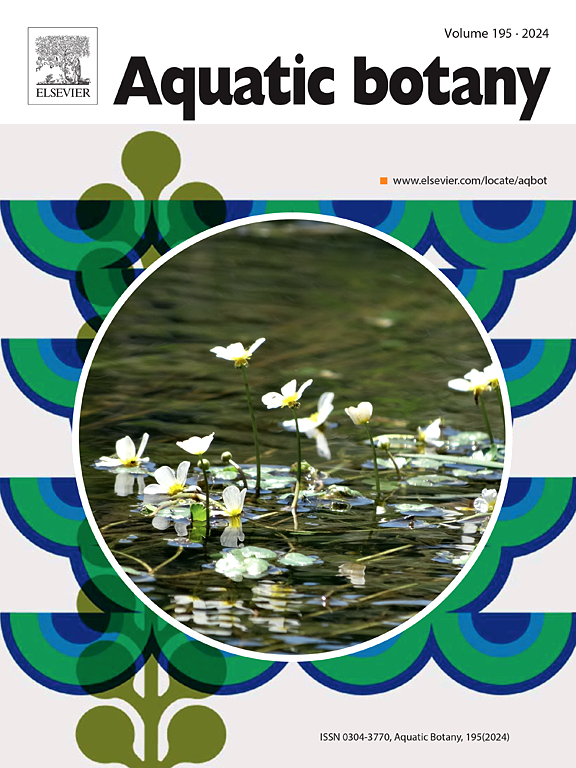The influence of physicochemical variables on plant species richness and distribution in the coastal salt marshes of the Berg River Estuary, South Africa
IF 2.6
4区 生物学
Q2 MARINE & FRESHWATER BIOLOGY
引用次数: 0
Abstract
The continuous distribution of coastal salt marsh habitats along an elevation gradient can be disrupted by tidal creeks running through them. Tidal creeks wind through salt marshes and create different environmental conditions for adjacent habitats. While studies have emphasized the importance of tidal creeks as links facilitating interactions in salt marshes, few have studied plant communities and physiochemical conditions associated with tidal creeks. This study determined the influence of creek physicochemical variables on the diversity and distribution of coastal salt marsh plants. Six transects in the lower reaches of the Berg River Estuary, South Africa were sampled over two seasons at sites with either the presence or absence of creeks. Species composition and abundance were analysed by replicate quadrats and paired with physicochemical variables (groundwater and sediment). The k-means of 20 species in 334 quadrats revealed four distinct clusters of salt marsh habitats, creeks, intertidal salt marsh, supratidal salt marsh and reeds. Species richness was higher along transects with creeks (16) compared to those with no creeks (5). The physiochemical variables, groundwater temperature, pH, dissolved oxygen, conductivity, and sediment variables (redox potential, organic content, percentage silt and percentage sand), significantly influenced the abundance of creek species. This study highlights the importance of tidal creeks in forming unique vegetation communities in salt marshes, where they act as refugia for intertidal species. It is suggested that tidal creek communities should be included in salt marsh vegetation descriptions and monitored in association with physicochemical variables in response to climate change.
物理化学变量对南非伯格河口沿海盐沼植物物种丰富度和分布的影响
沿海盐沼生境沿海拔梯度的连续分布会被穿过它们的潮汐溪流破坏。潮汐溪流蜿蜒穿过盐沼,为相邻的生境创造了不同的环境条件。虽然研究强调潮汐溪流作为促进盐沼互动的纽带的重要性,但很少有人研究与潮汐溪流相关的植物群落和理化条件。这项研究确定了溪流物理化学变量对沿岸盐沼植物多样性和分布的影响。在南非伯格河口下游的六个横断面上,对有无溪流的地点进行了两季采样。物种组成和丰度由重复的四分区分析,并与物理化学变量(地下水和沉积物)配对。对 334 个四分格中的 20 个物种进行的 k-means 分析显示,盐沼生境有四个不同的群组:溪流、潮间带盐沼、潮上带盐沼和芦苇。与没有溪流(5 条)的横断面相比,有溪流(16 条)的横断面物种丰富度更高。物理化学变量(地下水温度、pH 值、溶解氧、电导率)和沉积物变量(氧化还原电位、有机物含量、淤泥和沙的百分比)对溪流物种的丰富度有显著影响。这项研究强调了潮汐溪流在盐沼中形成独特植被群落的重要性,潮汐溪流是潮间带物种的避难所。建议将潮汐溪流群落纳入盐沼植被描述中,并结合物理化学变量对其进行监测,以应对气候变化。
本文章由计算机程序翻译,如有差异,请以英文原文为准。
求助全文
约1分钟内获得全文
求助全文
来源期刊

Aquatic Botany
生物-海洋与淡水生物学
CiteScore
3.80
自引率
5.60%
发文量
70
审稿时长
6 months
期刊介绍:
Aquatic Botany offers a platform for papers relevant to a broad international readership on fundamental and applied aspects of marine and freshwater macroscopic plants in a context of ecology or environmental biology. This includes molecular, biochemical and physiological aspects of macroscopic aquatic plants as well as the classification, structure, function, dynamics and ecological interactions in plant-dominated aquatic communities and ecosystems. It is an outlet for papers dealing with research on the consequences of disturbance and stressors (e.g. environmental fluctuations and climate change, pollution, grazing and pathogens), use and management of aquatic plants (plant production and decomposition, commercial harvest, plant control) and the conservation of aquatic plant communities (breeding, transplantation and restoration). Specialized publications on certain rare taxa or papers on aquatic macroscopic plants from under-represented regions in the world can also find their place, subject to editor evaluation. Studies on fungi or microalgae will remain outside the scope of Aquatic Botany.
 求助内容:
求助内容: 应助结果提醒方式:
应助结果提醒方式:


